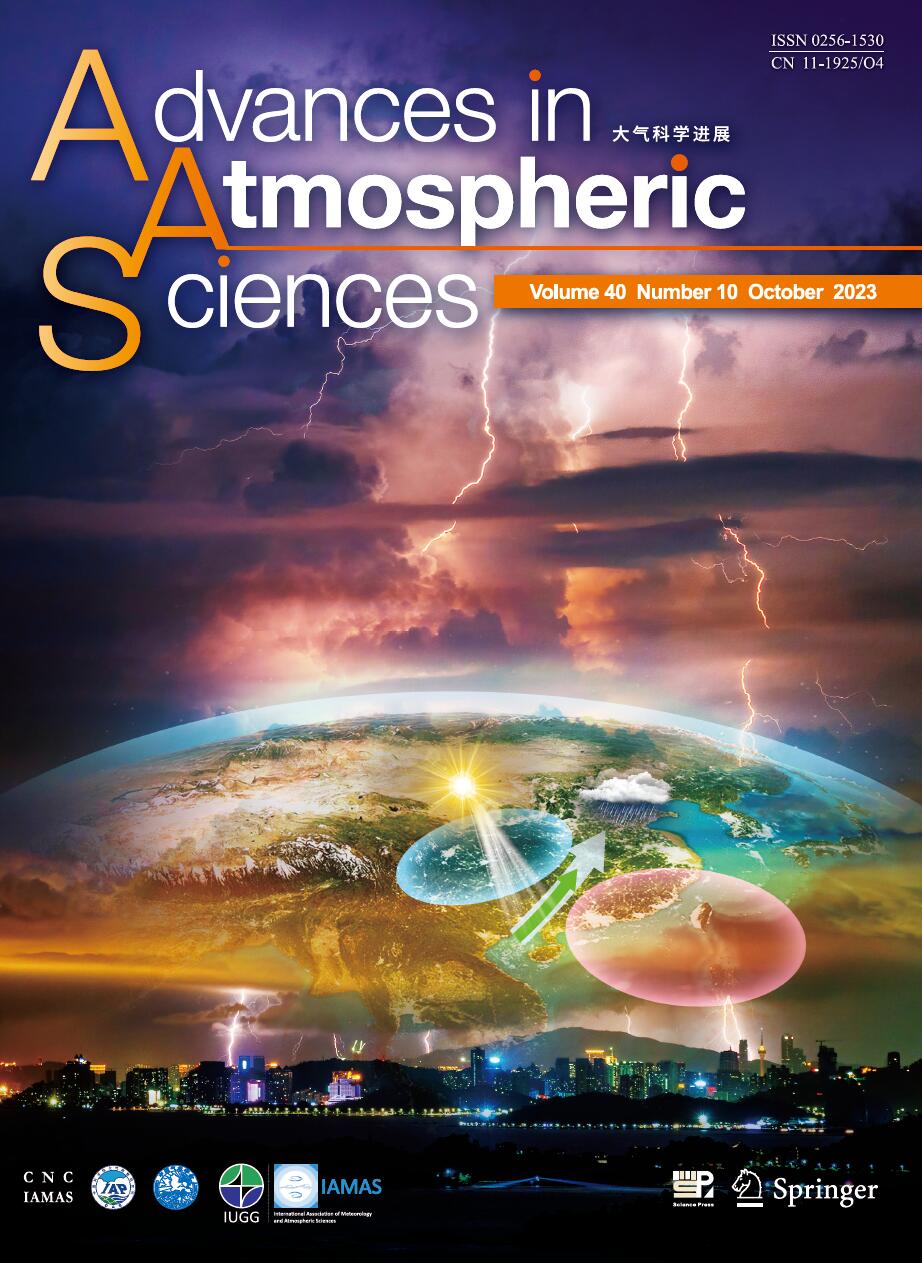| [1] |
LI Tao, ZHENG Xiaogu, DAI Yongjiu, YANG Chi, CHEN Zhuoqi, ZHANG Shupeng, WU Guocan, WANG Zhonglei, HUANG Chengcheng, SHEN Yan, LIAO Rongwei,
2014: Mapping Near-surface Air Temperature, Pressure, Relative Humidity and Wind Speed over Mainland China with High Spatiotemporal Resolution, ADVANCES IN ATMOSPHERIC SCIENCES, 31, 1127-1135.
doi: 10.1007/s00376-014-3190-8
|
| [2] |
Alexey V.ELISEEV, Igor I. MOKHOV,
2003: Amplitude-Phase Characteristics of the Annual Cycle of Surface Air Temperature in the Northern Hemisphere, ADVANCES IN ATMOSPHERIC SCIENCES, 20, 1-16.
doi: 10.1007/BF03342045
|
| [3] |
Chineke Theo Chidiezie, Li Weiping,
1999: IAP General Circulation Models: A First Step Towards Developing a Local Area Model for Weather Prediction in Nigeria, ADVANCES IN ATMOSPHERIC SCIENCES, 16, 119-132.
doi: 10.1007/s00376-999-0008-1
|
| [4] |
YU Lejiang, ZHANG Zhanhai, ZHOU Mingyu, Shiyuan ZHONG, Donald LENSCHOW, Hsiaoming HSU, WU Huiding, SUN Bo,
2010: Validation of ECMWF and NCEP--NCAR Reanalysis Data in Antarctica, ADVANCES IN ATMOSPHERIC SCIENCES, 27, 1151-1168.
doi: 10.1007/s00376-010-9140-1
|
| [5] |
CHEN Linling, Ola M. JOHANNESSEN, WANG Huijun, Atsumu OHMURA,
2011: Accumulation over the Greenland Ice Sheet as Represented in Reanalysis Data, ADVANCES IN ATMOSPHERIC SCIENCES, 28, 1030-1038.
doi: 10.1007/s00376-010-0150-9
|
| [6] |
Yadi LI, Xichen LI, Juan FENG, Yi ZHOU, Wenzhu WANG, Yurong HOU,
2024: Uncertainties of ENSO-related Regional Hadley Circulation Anomalies within Eight Reanalysis Datasets, ADVANCES IN ATMOSPHERIC SCIENCES, 41, 115-140.
doi: 10.1007/s00376-023-3047-0
|
| [7] |
Deniz BOZKURT, David H. BROMWICH, Jorge CARRASCO, Keith M. HINES, Juan Carlos MAUREIRA, Roberto RONDANELLI,
2020: Recent Near-surface Temperature Trends in the Antarctic Peninsula from Observed, Reanalysis and Regional Climate Model Data, ADVANCES IN ATMOSPHERIC SCIENCES, 37, 477-493.
doi: 10.1007/s00376-020-9183-x
|
| [8] |
Liu Qinyu, Jia Yinglai, Wang Xiaohua, Yang Haijun,
2001: On the Annual Cycle Characteristics of the Sea Surface Height in South China Sea, ADVANCES IN ATMOSPHERIC SCIENCES, 18, 613-622.
doi: 10.1007/s00376-001-0049-6
|
| [9] |
YU Yongqiang, HE Jie, ZHENG Weipeng, and LUAN Yihua,
2013: Annual Cycle and Interannual Variability in the Tropical Pacific as Simulated by Three Versions of FGOALS, ADVANCES IN ATMOSPHERIC SCIENCES, 30, 621-637.
doi: 10.1007/s00376-013-2184-2
|
| [10] |
Lixia ZHANG, Tianjun ZHOU, Nicholas P. KLINGAMAN, Peili WU, Malcolm ROBERTS,
2018: Effect of Horizontal Resolution on the Representation of the Global Monsoon Annual Cycle in AGCMs, ADVANCES IN ATMOSPHERIC SCIENCES, 35, 1003-1020.
doi: 10.1007/s00376-018-7273-9
|
| [11] |
QIAN Cheng, FU Congbin, Zhaohua WU, YAN Zhongwei,
2011: The Role of Changes in the Annual Cycle in Earlier Onset of Climatic Spring in Northern China, ADVANCES IN ATMOSPHERIC SCIENCES, 28, 284-296.
doi: 10.1007/s00376-010-9221-1
|
| [12] |
Yang Haijun, Liu Qinyu, Jia Xujing,
1999: On the Upper Oceanic Heat Budget in the South China Sea: Annual Cycle, ADVANCES IN ATMOSPHERIC SCIENCES, 16, 619-629.
doi: 10.1007/s00376-999-0036-x
|
| [13] |
QIAN Cheng, Zhaohua WU, FU Congbin, ZHOU Tianjun,
2010: On Multi-Timescale Variability of Temperature in China in Modulated Annual Cycle Reference Frame, ADVANCES IN ATMOSPHERIC SCIENCES, 27, 1169-1182.
doi: 10.1007/s00376-009-9121-4
|
| [14] |
LIN Pengfei, LIU Hailong, YU Yongqiang, ZHANG Xuehong,
2011: Response of Sea Surface Temperature to Chlorophyll-a Concentration in the Tropical Pacific: Annual Mean, Seasonal Cycle, and Interannual Variability, ADVANCES IN ATMOSPHERIC SCIENCES, 28, 492-510.
doi: 10.1007/s00376-010-0015-2
|
| [15] |
Chao Jiping, Yuan Shaoyu, Chao Qingchen, Tian Jiwei,
2002: A Data Analysis Study on the Evolution of the EI Ni?o/ La Ni?a Cycle, ADVANCES IN ATMOSPHERIC SCIENCES, 19, 837-844.
doi: 10.1007/s00376-002-0048-2
|
| [16] |
Seung-Jae LEE, E. Hugo BERBERY, Domingo ALCARAZ-SEGURA,
2013: Effect of Implementing Ecosystem Functional Type Data in a Mesoscale Climate Model, ADVANCES IN ATMOSPHERIC SCIENCES, 30, 1373-1386.
doi: 10.1007/s00376-012-2143-3
|
| [17] |
XIE Jiping, ZHU Jiang, XU Li, GUO Pinwen,
2005: Evaluation of Mid-Depth Currents of NCEP Reanalysis Data in the Tropical Pacific Using ARGO Float Position Information, ADVANCES IN ATMOSPHERIC SCIENCES, 22, 677-684.
doi: 10.1007/BF02918711
|
| [18] |
ZHOU Lian-Tong, HUANG Ronghui,
2010: An Assessment of the Quality of Surface Sensible Heat Flux Derived from Reanalysis Data through Comparison with Station Observations in Northwest China, ADVANCES IN ATMOSPHERIC SCIENCES, 27, 500-512.
doi: 10.1007/s00376-009-9081-8
|
| [19] |
ZHAO Tianbao, FU Congbin,
2009: Intercomparison of the Summertime Subtropical High from the ERA-40 and NCEP/NCAR Reanalysis over East Eurasia and the western North Pacific, ADVANCES IN ATMOSPHERIC SCIENCES, 26, 119-131.
doi: 10.1007/s00376-009-0119-8
|
| [20] |
ZENG Xinmin, LIU Jinbo, MA Zhuguo, SONG Shuai, XI Chaoli, WANG Hanjie,
2010: Study on the Effects of Land Surface Heterogeneitiesin Temperature and Moisture on Annual Scale Regional Climate Simulation, ADVANCES IN ATMOSPHERIC SCIENCES, 27, 154-163.
doi: 10.1007/s00376-009-8117-4
|















 AAS Website
AAS Website 
 AAS WeChat
AAS WeChat 
 DownLoad:
DownLoad: